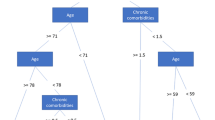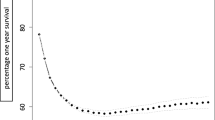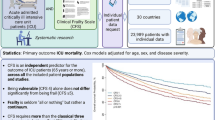Abstract
Objective
To develop a new method to evaluate the performance of individual ICUs through the calculation and visualisation of risk profiles.
Methods
The study included 102,561 patients consecutively admitted to 77 ICUs in Austria. We customized the function which predicts hospital mortality (using SAPS II) for each ICU. We then compared the risks of hospital mortality resulting from this function with the risks which would be obtained using the original function. The derived risk ratio was then plotted together with point-wise confidence intervals in order to visualise the individual risk profile of each ICU over the whole spectrum of expected hospital mortality.
Main measurements and results
We calculated risk profiles for all ICUs in the ASDI data set according to the proposed method. We show examples how the clinical performance of ICUs may depend on the severity of illness of their patients. Both the distribution of the Hosmer–Lemeshow goodness-of-fit test statistics and the histogram of the corresponding P values demonstrated a good fit of the individual risk models.
Conclusions
Our risk profile model makes it possible to evaluate ICUs on the basis of the specific risk for patients to die compared to a reference sample over the whole spectrum of hospital mortality. Thus, ICUs at different levels of severity of illness can be directly compared, giving a clear advantage over the use of the conventional single point estimate of the overall observed-to-expected mortality ratio.



Similar content being viewed by others
References
Knaus WA, Draper EA, Wagner DP, Zimmerman JE (1985) APACHE II: a severity of disease classification system. Crit Care Med 13:818–829
Knaus WA, Wagner DP, Draper EA, Zimmerman JE, Bergner M, Bastos PG, Sirio CA, Murphy DJ, Lotring T, Damiano A, Harrell FE Jr (1991) The APACHE III prognostic system. Risk prediction of hospital mortality for critically ill hospitalized adults. Chest 100:1619–1636
Zimmerman JE, Kramer AA, McNair DS, Malila FM (2006) Acute Physiology and Chronic Health Evaluation (APACHE) IV: hospital mortality assessment for today’s critically ill patients. Crit Care Med 34:1297–1310
Le Gall JR, Lemeshow S, Saulnier F (1993) A new simplified acute physiology score (SAPS II) based on a European/North American multicenter study. JAMA 270:2957–2963
Moreno RP, Metnitz PG, Almeida E, Jordan B, Bauer P, Campos RA, Iapichino G, Edbrooke D, Capuzzo M, Le Gall JR, SAPS 3 Investigators (2005) SAPS 3. From evaluation of the patient to evaluation of the intensive care unit. Part 2: development of a prognostic model for hospital mortality at ICU admission. Intensive Care Med 31:1345–1355
Metnitz PG, Moreno RP, Almeida E, Jordan B, Bauer P, Campos RA, Iapichino G, Edbrooke D, Capuzzo M, Le Gall JR, SAPS 3 Investigators (2005) SAPS 3. From evaluation of the patient to evaluation of the intensive care unit. Part 1: objectives, methods and cohort description. Intensive Care Med 31:1336–1344
Reis Miranda D, Ryan DW, Schaufeli WB, Fidler V (eds) (1997) Organization and management of intensive care: a prospective study in 12 European countries. Springer, Berlin
Lovegrove J, Valencia O, Treasure T, Sherlaw-Johnson C, Gallivan S (1997) Monitoring the results of cardiac surgery by variable life-adjusted display. Lancet 350:1128–1130
Moreno R, Reis Miranda D (1998) Nursing staff in intensive care in Europe. The mismatch between planning and practice. Chest 113:752–758
The UK Neonatal Staffing Study Group (2002) Patient volume, staffing, and workload in relation to risk adjusted outcomes in a random stratified sample of UK neonatal intensive care units: a prospective evaluation. Lancet 359:99–107
Metnitz B, Metnitz PG, Bauer P, Valentin A, ASDI Study Group (2009) Patient volume affects outcome in critically ill patients. Wien Klin Wochenschr 121:34–40
Metnitz PG, Reiter A, Jordan B, Lang T (2004) More interventions do not necessarily improve outcome in critically ill patients. Intensive Care Med 30:1586–1593
Connors AF, Speroff T, Dawson NV, Thomas C, Harrell FE Jr, Wagner D, Desbiens N, Goldman L, Wu AW, Califf RM, Fulkerson WJ, Vidaillet H, Broste S, Bellamy P, Lynn J, Knaus WA, The SUPPORT investigators (1996) The effectiveness of right heart catheterization in the initial care of critically ill patients. JAMA 276:889–897
Acknowledgments
The study was supported by the Austrian Centre for Documentation and Quality Assurance in Intensive Care Medicine (ASDI). Our special thanks to the participants from all the ICUs that participated in the project.
Author information
Authors and Affiliations
Corresponding author
Additional information
On behalf of the ASDI Study Group.
Electronic supplementary material
Below is the link to the electronic supplementary material.
Rights and permissions
About this article
Cite this article
Moreno, R.P., Hochrieser, H., Metnitz, B. et al. Characterizing the risk profiles of intensive care units. Intensive Care Med 36, 1207–1212 (2010). https://doi.org/10.1007/s00134-010-1852-2
Received:
Accepted:
Published:
Issue Date:
DOI: https://doi.org/10.1007/s00134-010-1852-2




